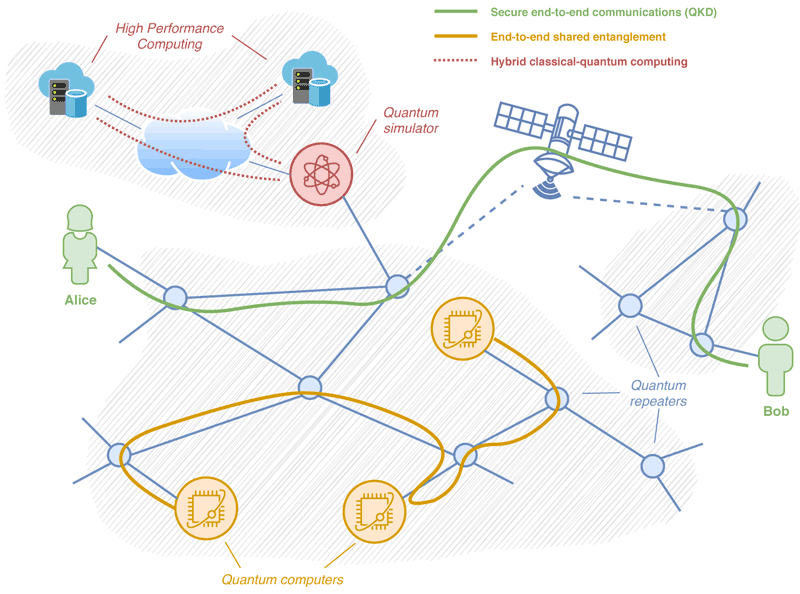by Claudio Cicconetti Marco Conti and Andrea Passarella (IIT-CNR, Italy)
A new quantum era is dawning, full of exciting possibilities and new applications. At IIT-CNR we are working on quantum networks, which extend to geographical distance interactions between quantum systems. We are aiming to develop secure identification and communication, distributed computation, and tighter integration with classical computing systems. The long-term vision we are working towards is a quantum internet, where quantum components co-exist with legacy-Internet components, or the entire network may be exclusively built out of quantum devices.
Quantum technologies exploit fundamental properties of matter at exceedingly small scales to perform tasks that would be too complicated or simply not possible with conventional paradigms. Examples include unconditionally securing communications, solving problems of practical prohibitive computational complexity in a matter of seconds (the “quantum advantage”), and deepening our understanding of complex physical systems.
The evolution of quantum computing can be accelerated by interconnecting them so they can perform non-local computations on shared quantum states via the upcoming quantum internet, which in its final form (illustrated in Figure 1) will allow quantum systems all over the world to exchange flying qubits much like today’s computers exchange classical information (in bits) via the internet. The road to this outcome is long and paved with obstacles, but along the way are milestones that provide useful results with a practical impact [1].
In the Ubiquitous Internet Research Group at the Institute of Informatics and Telematics (IIT) of the National Research Council (CNR), in Pisa (Italy), we are climbing the first steps of the quantum internet ladder by investigating the integration of quantum key distribution (QKD) solutions and classical internet devices and protocols, within the national project QUANCOM (2021-2023) funded by the Italian Ministry of University and Research. QKD exploits the no-cloning property of qubits, carried by photons, to provide communication between parties, e.g., Alice and Bob in Figure 1, that cannot be overheard by unintended recipients: extracting the information from a qubit requires a measurement to be performed, which, however, destroys the quantum state. Based on this principle, we can define protocols that allow symmetric keys to be exchanged with forward secrecy. This is a quality that non-quantum cryptographic protocols lack, and it means that it will never, not even in the distant future, be possible to decipher data exchanged today through QKD. Of course, this is desirable for sensitive data, such as government and military data, but also for our personal medical and biometric data. Recent technology development trends suggest that mass deployment may be possible within the next few years [2]. Indeed, the European Commission and European Space Agency have recently signed a joint declaration for the construction of a European Quantum Communication Infrastructure within the framework of the EuroQCI initiative [L1].

Figure 1: The quantum internet will interconnect quantum systems all over the globe via an integrated terrestrial fibre optic and satellite infrastructure and a network of quantum repeaters. It will allow unconditionally secure traditional communications, as well as distributed computing patterns for quantum computers and simulators.
Meanwhile, we are also pursuing a longer-term research direction. With QKD, even though quantum communications are used to exchange keys, we are fundamentally interested in exchanging classical information, which can encode data such as bank account numbers and fingerprints. A more advanced exploitation can be obtained by enabling remote quantum systems to cooperate with one another. Let us consider quantum computers, for instance. We are now in the noisy intermediate-scale quantum (NISQ) phase, which means that the computing power of quantum computers, that is the number of qubits they can manipulate, is expected to remain quite low in the next 5 to 10 years and insufficient to exhibit a computational advantage over classical computers for most applications. However, multiple quantum computers around the globe may join forces to carry out more complex computations, which are unattainable by any of them individually. For this purpose, shared entanglement of qubits is crucial, as it allows remote entities to operate on quantum states composed of qubits that are not physically located all in one single computer but spread over multiple parties through the quantum internet (see Figure 1). Our research group is investigating the novel architectures and protocols required to achieve shared entanglement via the “quantum repeaters”, which are intermediate boxes that extend the physical range of quantum links through teleportation [3]. The latter has nothing to do with sci-fi tractor beams; it merely refers to a technique for moving the state of a qubit from one place to another, albeit destroying the original version every time due to the no-cloning theorem.
In any case, it is unrealistic to assume that there will ever be a switchover from classical to quantum computing, as it seems far more advantageous to use them in a cooperative way. Even today, despite the disproportionate level of maturity between classical and quantum computers, there are use cases where their combination is beneficial. We will investigate such opportunities in the project HPCQS (2021-2025), funded by the EuroHPC Joint Undertaking and coordinated by the Jülich Research Centre in Germany, which aims to develop a European hybrid infrastructure that can operate smoothly both traditional high-performance computing (HPC) resources and two quantum simulators with 100+ qubits, which reproduce the behaviour of materials at very low temperatures, for which several use cases of scientific, societal, and business interest have been identified, including physics simulations and quantum machine learning.
Link:
[L1] https://digital-strategy.ec.europa.eu/en/policies/european-quantum-communication-infrastructure-euroqci
References:
[1] S. Wehner, D. Elkouss, and R. Hanson: “Quantum internet: A vision for the road ahead,” Science, vol. 362, no. 6412, Oct. 2018, doi: 10.1126/science.aam9288.
[2] Y.-A. Chen et al.: “An integrated space-to-ground quantum communication network over 4,600 kilometres,” Nature, vol. 589, no. 7841, Jan. 2021, doi: 10.1038/s41586-020-03093-8.
[3] C. Cicconetti, M. Conti, and A. Passarella: “Request Scheduling in Quantum Networks”, IEEE Trans. on Quantum Eng., vol. 2, 2021, doi: 10.1109/TQE.2021.3090532.
Please contact:
Claudio Cicconetti, IIT-CNR, Italy
+39 348 288 8602











